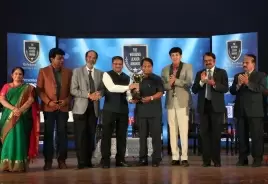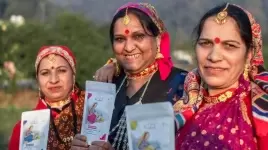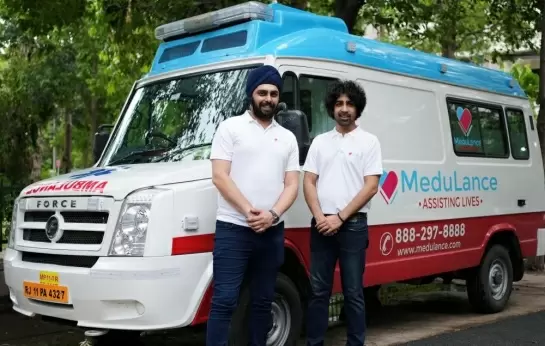“We believe that the children who eat it are our children too”

12-October-2012
Vol 3 | Issue 41
Women in aprons, with their heads covered, stir the bubbling cauldrons with their giant ladles. ‘Kadhi’ is on the menu, and the turmeric-laced, savoury concoction made of yoghurt gurgles over the fire even as the ‘pakodas’ (deep fried gram flour balls), that will soon be dunked into it, sizzle to the surface in giant woks placed in another corner of the kitchen.
The ‘kadhi’ will soon be ready, along with a vegetable accompaniment. If it is ‘kadhi’ today, it could be rajma-rice, chana-pulao or puri-sabzi on other days. The children for whom this food is prepared enjoy the variety and taste, and there is no compromising on that.
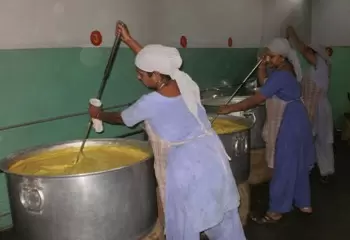 |
|
Women in aprons, with their heads covered, stir the bubbling cauldrons with their giant ladles (Photos: WFS)
|
By 9.30 am, the food is ready and packed in 20-kilo steel containers, along with two ladles of three and five kilograms, for precise measurement. A rickshaw then transports these containers to the nearby anganwadi on time as part of ‘Sabla’, a nutritional programme run by the government for girls aged 11 to 18 years.
This food is also supplied for the supplementary nutrition programme meant to provide pregnant and lactating women, as well as for children up to six years, supplementary nutrition. These are programmes under the government’s Integrated Child Development Services (ICDS) Scheme, said to be the biggest nutritional intervention of its kind in the world.
Delhi-based Ashok Rao, whose organization, the Swami Sivananda Memorial Institute (SSMI) runs five such kitchens catering to around 116 anganwadi centres in Jahangirpuri, brings the formidable talents of a highly qualified engineer to this project.
But what made him decide to switch from heavy machinery to pots and pans? Convinced that the country was staring at a huge crisis in urban hunger, Rao sought premature retirement from Bharat Heavy Electricals Limited (BHEL) and set to work on a model that could deliver wholesome food efficiently to those who needed it most.
What emerged was the Jahangirpuri Model, named after one of Delhi’s roughest corners – a resettlement colony that is also the largest recycler of plastic waste spewed out of the city.
“What disturbed me was that the government spends Rs 25,000 crore annually on its food programmes, and everywhere there is waste and corruption,” says Rao. If this money were to be used more carefully, he believed, the government’s nutrition programmes could serve their intended purpose of providing good food, even while creating employment for women and buttressing the earnings of small and marginal farmers by eliminating middlemen.
There are three basic principles behind what has now come to be termed as the Jahangirpuri Model: Transparency – achieved not through food inspectors, but by locating the kitchen in the midst of the community; accountability, by hiring local women; and finally by ensuring hot, cooked meals since the kitchens are only a few metres away from the anganwadis.
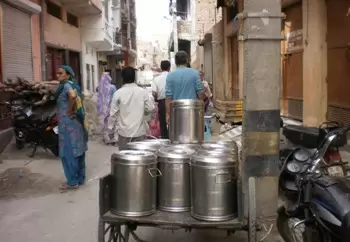 |
|
A rickshaw loaded with the food packed in 20-kilo steel containers is on its way to feed hundreds of children in Jahangirpuri
|
As opposed to getting such food processed in mechanical or semi-mechanical, capital-intensive kitchens that minimise human intervention, here there are decentralised, low investment kitchens that maximise women’s employment without compromising on food safety.
Hygiene is achieved through standard operating procedures. The Jahangirpuri Model has adopted a unique, cheap and effective method to ensure this. Every stove is numbered, and a sample of the food that is cooked on it is placed in a small stainless steel box bearing the same number, so that if there are any complaints it can be traced to the right source. So far, no complaints have come back to SSMI, indicating that its quality control arrangements are working.
The SMMI began with eight women to run its kitchens. They in turn formed a Self Help Group (SHG). Today, there are eight such SHGs on SMMI rolls in Jahangirpuri with each woman worker earning around Rs 2,000 (US$1=Rs 52) per month for about six hours of work, apart from free meals, uniforms, and transportation.
Project coordinator, Paremshwar Parida stresses that for him the quality of the food is of primary consideration. “When the project from the state government first came to us it was for 45,000 beneficiaries. We decided to scale down because we wanted to prepare food that made a difference. Now SMMI has the capacity to reach out to 15,000 beneficiaries,” he says.
Parida has a good relationship with the women workers in the kitchen. Along with a steady flow of easy banter with them, he keeps a keen eye focused on the food that is being prepared. He has drawn up a daily chart of activities that the women religiously follow.
Explains Mona, 40, who has been working in the SMMI kitchens for the last seven years, “I live fairly close by and I reach the kitchen by 6.30 am. On the previous day we would have cleaned the rice and dal needed for today’s meal so we can start cooking right away. But the first thing we do is to sweep the place, wash our hands, change our clothes and then get down to our work stations by 7 am.”
Rao has put his engineering acumen to work in conceptualising safe kitchens. The first problem was to run a kitchen from a home standing on a 25 yard plot, which is the normal size of housing plots in Jahangirpuri.
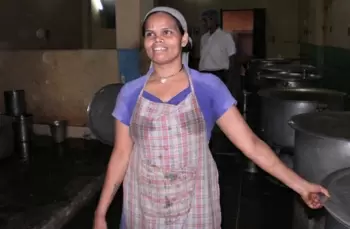 |
|
Mona, 40, has been working in the SMMI kitchens for the last seven years
|
Then there were technical problems to be sorted out: How, for instance, do you evacuate heat in a small, windowless kitchen? “First we thought we would pump in cold air but the flames were disturbed. We finally settled for exhaust fans, with the women coming out regularly from the cooking area to hydrate themselves,” says Rao.
Iksha Chhabra, a nutrition expert with the SMMI, observes that programmes like the ICDS and the Mid Day Meal scheme were really meant to provide supplementary nutrition.
No one understands this more than the women who sweat over fires cooking nutritious and tasty food. Says Mona, “Many mothers in Jahangirpuri work as labourers and have no time or money to ensure wholesome food for their children. That’s why we always make sure that our food tastes good, because we believe that the children who eat it are our children too.” -Women's Feature Service


